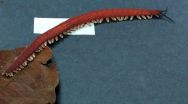(Press-News.org) New research shows that courtship rituals evolve very fast in cichlid fish in Lake Malawi. Whenever species evolve to feed at different depths, their courtship evolves as well. In the shallows where the light is good, males build sand castles to attract females. Males of deep-dwelling species dig less elaborate pits and compensate with longer swimming displays. The results are published in the open-access journal Frontiers in Ecology and Evolution.
"Lake Malawi cichlids are famous for the diversity and fast evolution of their feeding habits, body form, and sex determination system," says Ryan York, a graduate student at Stanford University and lead author of the study. "Here we show for the first time that their courtship rituals also evolve exceptionally fast."
The researchers made a DNA-based "family tree" for 75 species (out of over 500) of Lake Malawi cichlids, noting for each whether males build castles or dig pits. The tree looks like a messy patchwork: the closest relatives of species with castle-building males often have pit-digging males, and vice versa. York and colleagues conclude that individual species have repeatedly moved back and forth between castle building and pit digging during cichlid evolution.
Lake Malawi is approximately 5 million years old, which means that all evolutionary changes in the cichlids' ecology -- including courtship behavior -- have happened within this extremely short period.
The evolution of cichlid courtship seems to be driven by shifts in the average depth at which each species feeds. Castles require more effort to build but are more striking to females in clear, shallow waters. In species that live at greater depth where light is scarce, castle building does not pay off.
In support of their theory, the researchers show that castle-building species live at an average depth of 15 meters in Lake Malawi, compared to 30 meters for pit-digging species.
The body of pit-diggers is likewise better suited for living at greater depths. For example, females and males of pit-digging species can extend their upper jaw further towards prey, allowing them to catch fast-moving animal plankton on the murky lake bottom. Their retina is less able to detect UV light -- a wavelength that is too short to reach the depths.
Digging pits takes less effort than building castles, and pit-digging males seem to use the time and energy saved to good effect. Studying courtship in one castle-building and one pit-digging species in detail inside aquaria, the researchers found that males of the latter invest twice as much time in display behavior, for example swimming towards females or extending their fins and gill cover to look larger.
Pits and castles are only used during courtship and mating, and have no other function. If a female likes what she sees, she lays her eggs inside the pit or castle, to be fertilized by the male. She then keeps them in her mouth for several weeks, never eating until they hatch.
INFORMATION:
Video of castle building and courtship behavior in the Lake Malawi cichlid Mchenga conophoros, inside aquarium:
https://vimeo.com/122301018
In online coverage, please include a link to the open-access article, which will be published here on Wed 18 Mar 2015 5:00 PM CET: http://journal.frontiersin.org/article/10.3389/fevo.2015.00018/full
(a non-typeset, full-text preprint is currently available at the same link)
Article title: Evolution of bower building in Lake Malawi cichlid fish: Phylogeny, morphology, and behavior
Journal: Frontiers in Ecology and Evolution
Authors: York R, Patil C, Hulsey D, Anoruo O, Streelman T and Fernald R
DOI: 10.3389/fevo.2015.00018
Researcher contact:
Ryan A. York
Stanford University
Stanford, USA
E-mail: ryanayork@gmail.com
Tel: +1 650-575-4507
About Stanford University
Stanford University, located between San Francisco and San Jose in the heart of California's Silicon Valley, is one of the world's leading teaching and research universities. Since its opening in 1891, Stanford has been dedicated to finding solutions to big challenges and to preparing students for leadership in a complex world.
About Frontiers
Frontiers is a leading community-driven open-access publisher. Established by scientists in 2007, Frontiers drives innovations in peer review, post-publication review, impact metrics for articles and authors, democratic evaluation of the best research papers, research networking and a growing ecosystem of open-science tools. The "Frontiers in" journal series has published over 30,000 peer-reviewed articles across 53 journals and 400 academic disciplines, which receive 8 million monthly views, and are supported by over 200,000 leading researchers worldwide. Frontiers for Young Minds, a philanthropic initiative by Frontiers, is a science journal that involves young people in the review of articles. In 2014, Frontiers won the ALPSP Gold Award for Innovation in Publishing. For more information, visit: http://www.frontiersin.org
Men and women who adapt their daily diet to meet current UK dietary guidelines could reduce their risk of a heart attack or a stroke by up to a third, according to a new study by King's College London.
The study, published in the American Journal of Clinical Nutrition, recruited healthy middle-aged and older men and women to compare the effects on risk factors for cardiovascular disease (CVD) of following a diet based on UK health guidelines compared with a traditional British diet. The predicted risk of CVD over the next 10 years for the participants was estimated to ...
In diseases such as asthma and chronic obstructive pulmonary disease (COPD), the body produces too much mucus, making breathing difficult. New research from Washington University School of Medicine in St. Louis provides clues to potentially counteract inappropriate mucus production.
"The new study lays the groundwork for developing treatments for diseases such as asthma, COPD, cystic fibrosis and even certain cancers," said senior author Thomas J. Brett, PhD, assistant professor of medicine. "It also solves a 20-year mystery about the role of a protein that has long been ...
Researchers at the San Diego Supercomputer Center (SDSC) and the Moores Cancer Center at the University of California, San Diego, have described for the first time the molecular mechanism of cancer development caused by well-known "resistance" mutations in the gene called epidermal growth factor receptor (EGFR).
While these mutations were known for quite a long time, the question as to why they cause cancer or make some drugs ineffective was still not answered.
The study, called "Molecular Determinants of Drug-Specific Sensitivity for Epidermal Growth Factor Receptor ...
Tropical Cyclone Bavi weakened to a depression and NASA's RapidScat instrument measured its waning winds from space.
On March 17 the RapidScat instrument aboard the International Space Station (ISS) measured Bavi's surface winds from 01:28 to 3:01 UTC. RapidScat data showed surface winds were strongest winds in the northwestern quadrant. Sustained winds were near 17 m/s (38 mph/61 kph) and weaker around the rest of the storm.
On March 18 at 0000 UTC (March 17 at 8 p.m. EDT), the Joint Typhoon Warning Center noted that Bavi's maximum sustained winds dropped to 25 knots ...
Cambridge, Mass. - March 17, 2015 - The velvet worm is a slow-moving, unassuming creature. With its soft body, probing antennae, and stubby legs, it looks like a slug on stilts as it creeps along damp logs in tropical climates.
But it has a secret weapon. In the dark of night, when an unsuspecting cricket or termite crosses its path, the worm unleashes an instantaneous torrent of slime. Two fine jets of the gluey substance spray out of openings on its head, oscillating in all directions to cast a sticky net that entraps prey and stops it in its tracks.
Captivated, ...
While unconscious race and social class biases were present in most trauma and acute-care clinicians surveyed about patient care management in a series of clinical vignettes, those biases were not associated with clinical decisions, according to a report published online by JAMA Surgery.
Disparities in the quality of care received by minority patients have been reported for decades across multiple conditions, types of care and institutions, according to the study background. Adil H. Haider, M.D., M.P.H., of Brigham and Women's Hospital, Boston, conducted a web-based survey ...
ANN ARBOR, Mich. - Drugs aimed at quelling the behavior problems of dementia patients may also hasten their deaths more than previously realized, a new study finds.
The research adds more troubling evidence to the case against antipsychotic drugs as a treatment for the delusions, hallucinations, agitation and aggression that many people with Alzheimer's disease and other dementias experience.
In the new issue of the journal JAMA Psychiatry, researchers report findings from nearly 91,000 American veterans over the age of 65 with dementia.
Data from each patient who ...
TORONTO (March 18, 2015) - People with a severe form of schizophrenia have major differences in their brain networks compared to others with schizophrenia, bipolar disorder and healthy individuals, a new study from the Centre for Addiction and Mental Health (CAMH) shows.
The study, which used a novel approach to map brain networks, was led by researchers at the Campbell Family Mental Health Research Institute at CAMH and published in this week's JAMA Psychiatry.
"Finding ways to help this particular group of people with schizophrenia is a priority as recovery is ...
COLLEGE STATION - A ground-breaking Texas A&M AgriLife Research-led study on corn has identified useful gene variations for yield increases, drought tolerance and aflatoxin resistance that could make a real difference to Texas producers in the years to come, according to researchers.
The study, titled "Genome Wide Association Study for Drought, Aflatoxin Resistance, and Important Agronomic Traits of Maize Hybrids in the Sub-Tropics" was recently published in PLOS ONE, an international, peer-reviewed, open-access, online publication.
The study included the growing years ...
From computers, tablets, and smartphones to cars, homes, and public transportation, our world is more digitally connected every day. The technology required to support the exchange of massive quantities of data is critical. That's why scientists and engineers are intent on developing faster computing units capable of supporting much larger amounts of data transfer and data processing.
A new study published in Nature Photonics by Tel Aviv University researchers finds that new optical materials could serve as the nuts and bolts of future ultra-high-speed optical computing ...


